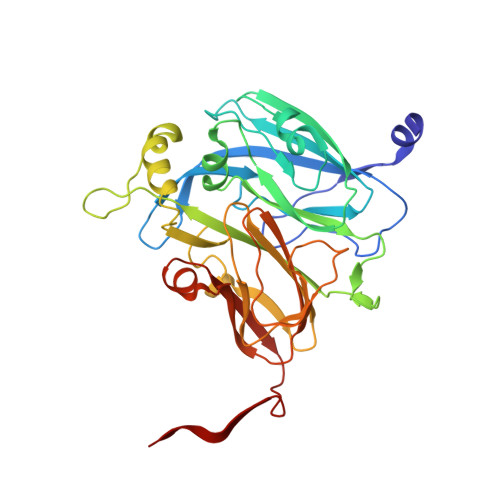A rearranging ligand enables allosteric control of catalytic activity in copper-containing nitrite reductase.
Wijma, H.J., Macpherson, I., Alexandre, M., Diederix, R.E., Canters, G.W., Murphy, M.E., Verbeet, M.P.(2006) J Mol Biol 358: 1081-1093
- PubMed: 16574144
- DOI: https://doi.org/10.1016/j.jmb.2006.02.042
- Primary Citation of Related Structures:
1ZDQ, 1ZDS - PubMed Abstract:
In Cu-containing nitrite reductase from Alcaligenes faecalis S-6 the axial methionine ligand of the type-1 site was replaced (M150G) to make the copper ion accessible to external ligands that might affect the enzyme's catalytic activity. The type-1 site optical spectrum of M150G (A(460)/A(600)=0.71) differs significantly from that of the native nitrite reductase (A(460)/A(600)=1.3). The midpoint potential of the type-1 site of nitrite reductase M150G (E(M)=312(+/-5)mV versus hydrogen) is higher than that of the native enzyme (E(M)=213(+/-5)mV). M150G has a lower catalytic activity (k(cat)=133(+/-6)s(-1)) than the wild-type nitrite reductase (k(cat)=416(+/-10)s(-1)). The binding of external ligands to M150G restores spectral properties, midpoint potential (E(M)<225mV), and catalytic activity (k(cat)=374(+/-28)s(-1)). Also the M150H (A(460)/A(600)=7.7, E(M)=104(+/-5)mV, k(cat)=0.099(+/-0.006)s(-1)) and M150T (A(460)/A(600)=0.085, E(M)=340(+/-5)mV, k(cat)=126(+/-2)s(-1)) variants were characterized. Crystal structures show that the ligands act as allosteric effectors by displacing Met62, which moves to bind to the Cu in the position emptied by the M150G mutation. The reconstituted type-1 site has an otherwise unaltered geometry. The observation that removal of an endogenous ligand can introduce allosteric control in a redox enzyme suggests potential for structural and functional flexibility of copper-containing redox sites.
Organizational Affiliation:
Leiden Institute of Chemistry, Leiden University, P.O. Box 9502, 2300 RA Leiden, The Netherlands.
















